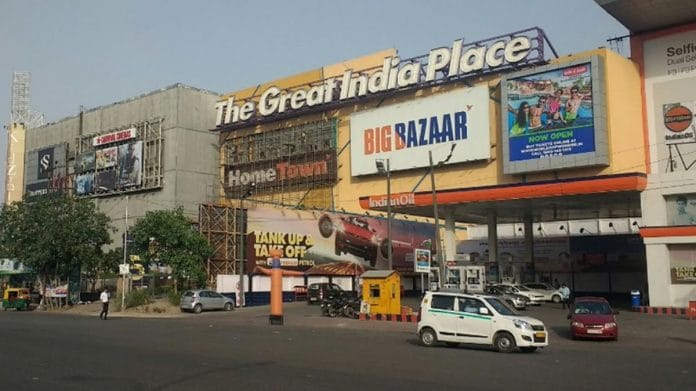The two districts of western Uttar Pradesh — Ghaziabad and Gautam Buddha Nagar or Noida — derive their importance largely from being close to, in fact sharing their border with, the national capital. Their connection to Delhi is well regarded since they are satellite hubs for manufacturing and the construction sector. With the announcement of 75 per cent private sector job reservations in the neighbouring state of Haryana, these two districts may potentially benefit from relocation. With this in view, it becomes important to understand the growth trajectories and sectoral patterns of these two districts recently.
Districts like Noida, Ghaziabad, Gurgaon and Faridabad have the advantage of a large market, agglomeration, and migrating population because of their proximity to the national capital. In a previous article, we observed that Noida has emerged as the most important district of Uttar Pradesh in the last decade. A rigorous empirical analysis of this region, and of the broader National Capital Region (NCR), could give us valuable insights into development processes. While the district income data for Haryana is not available for the previous decade, a comprehensive study of inter-district disparity in Haryana is. The evidence there suggests that in 1999-2000, Gurgaon’s contribution (15 per cent) to the state’s economy was slightly higher than Faridabad’s (12 per cent). However, their shares increased substantially during the first decade of this century. In 2010-11, Gurgaon’s contribution (20 per cent) was significantly higher than Faridabad (13 per cent)
Before proceeding further, a word about data sources is in order. The Gross District Domestic Product (GDDP) data is compiled by the Directorate of Economics and Statistics of respective states. The Directorate of Economics & Statistics, Uttar Pradesh, has been very prompt in providing the district income estimates. This is available for as recent as 2019-20, which allows us to undertake the present study. We make use of three available DDP series (1999-00, 2004-05 and 2011-12) covering the last two decades. The methodologies used in constructing these different series are not strictly comparable. To circumvent this, we work with percentage shares and do not compute any growth rates. We take the population data from the population census for 2001 and 2011. We extrapolate this data for the other years, as is the usual practice. To arrive at per capita income (or PCGDDP) we divide the GDDP with this population. We have included the Hapur district, carved from Ghaziabad in 2011, in its parent district in constructing the district’s income and population. We use current prices data, to maintain consistency. For illustrations in this article, we keep the name of Gautam Buddha Nagar district as Noida. NOIDA, an acronym for New Okhla Industrial Development Authority, has become entrenched in popular vocabulary. It may be pertinent to note here that Gautam Buddha Nagar district (Noida) was carved as a separate district in 1997 from Ghaziabad district.
Also Read: The old Bimaru states have new boom towns. But only in pockets
The growth of Ghaziabad and Noida
According to the 2011 Census, the geographical area of Ghaziabad district (1,839 km2; including 660 km2 of Hapur district) is about 1.5 times that of Noida (1,282 km2). The decadal population growth (2001-11) for the two districts was 42.3 per cent (Ghaziabad) and 37.1 per cent (Noida). As expected, this population growth is higher than Uttar Pradesh’s average (25.8 per cent) in the same period. It is important to note here that Ghaziabad is three times more densely populated than Noida (1,286 vs 3,971 persons per km2). However, Noida seems to be more urbanised than Ghaziabad (68 per cent vs 59 per cent, according to the 2011 Census). The proportion of Scheduled Caste (SC) in these two districts – Noida (16.5 per cent) and Ghaziabad (13.1 per cent) – is less than the state’s average (21 per cent). As is the case with the entire Uttar Pradesh, the tribal population is negligible in these districts.
In Figure 1, we show how the share of these two districts in the state’s economy has evolved over the last two decades. During the early 2000s, Ghaziabad’s contribution was higher than Noida. But Noida caught up in the latter part of the decade. The previous decade, 2010-2020, has seen a meteoric rise in the economy of Noida. It is important to note here that the DDP data may not be strictly comparable across the three series owing to methodological changes. Even allowing for this change, we see that the trend picks up in the period after 2011-12. It increased from 6.5 per cent to 8.6 per cent in a span of less than a decade. Given the size of Uttar Pradesh, it is a substantial rise. What about the per capita income and contribution from various sectors?
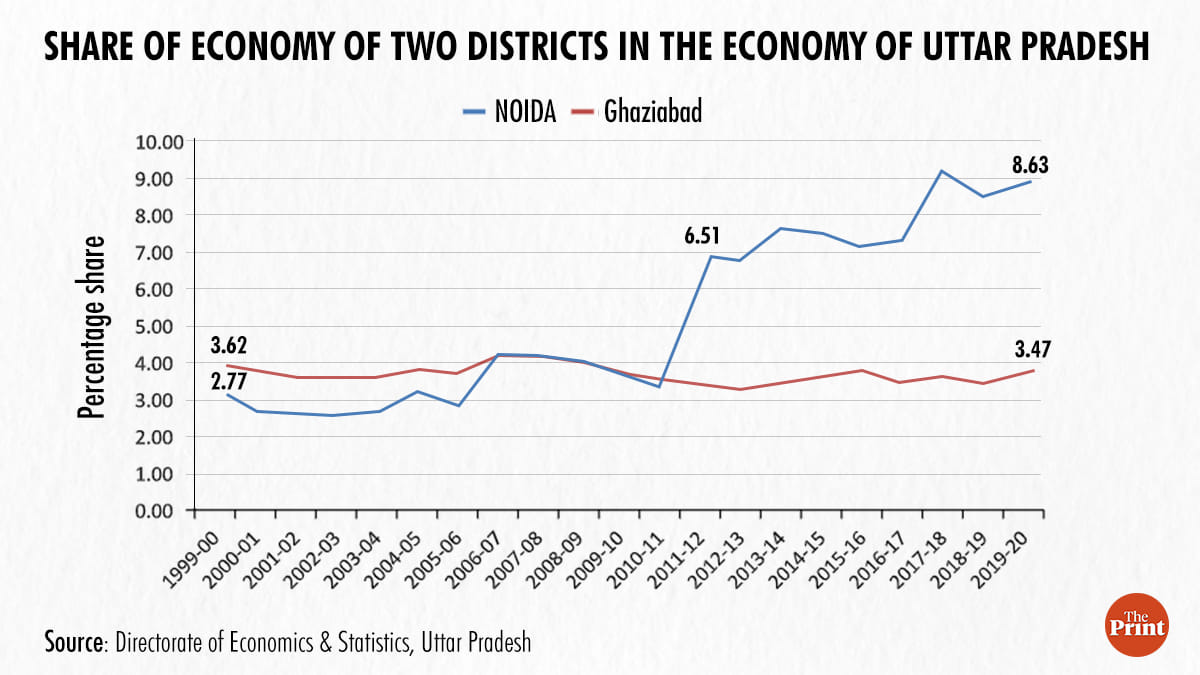
In Figure 2, we plot the evolution of per capita income (PCI) of these districts as a percentage of the state of Uttar Pradesh. During the early 2000s, the per capita income of Ghaziabad was almost double of the state. Noida, on the other hand, was about twice that of Ghaziabad. This pattern remains for the whole of the decade. However, with the disproportionate rise in population in Ghaziabad, coupled with economic decline, the per capita income of Ghaziabad has fallen consistently. As of 2019-20, it is just 22 per cent higher than Uttar Pradesh’s average. This is a considerable decline. On the other hand, Noida has seen a steep rise in per capita income in the last decade – from 7.8 times the state’s average in 2011-12 to about 9 times in 2019-20.
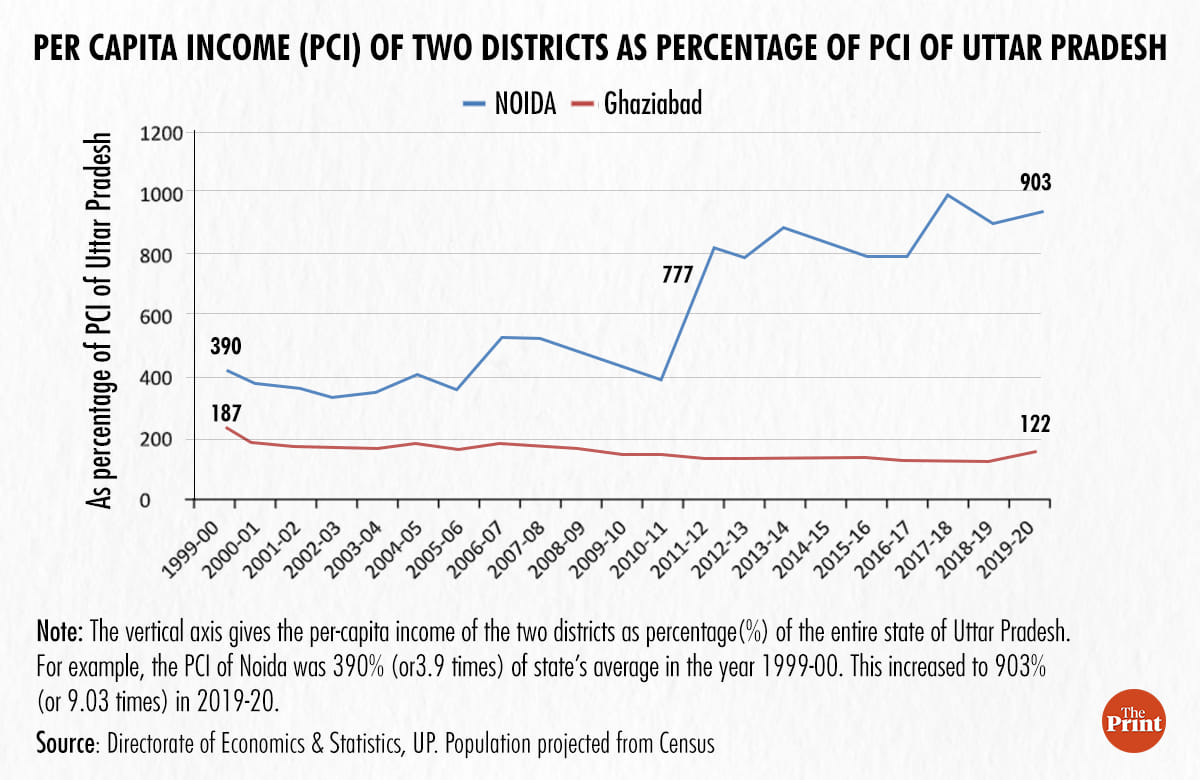
Also Read: The Indian state where development is more on a par with Pakistan than India
Transformative sectors
An interesting question here is: which sector of the economy has contributed to this diverging performance of the two districts? Because of the comparability of data and improved methodology, we focus on the 2011-20 period to analyse the structure of the economy. The manufacturing sector in Uttar Pradesh is very small. It has hovered around in the range of 10-15 per cent during this period (Figure 3). The manufacturing sector of Noida was just below 2.7 times that of Ghaziabad in 2011-12 (Rs 17,189 crore vs Rs 6,299 crore) This gap has now widened to about 4.5 times during 2019-20 (Rs 11,863 cr. vs Rs 53,121 cr.). In Noida’s economy, the manufacturing sector accounted for around 40 per cent in the first half of the previous decade, with a maximum touching in 2017-18. This sudden jump in 2017-18 seems intriguing. This is the period that immediately followed demonetisation (November 2016). This increase in the share of the manufacturing sector could be a result of a larger fall in the shares of other sectors of the economy. A similar, but less prominent, the trend is seen for the manufacturing sector in Ghaziabad.
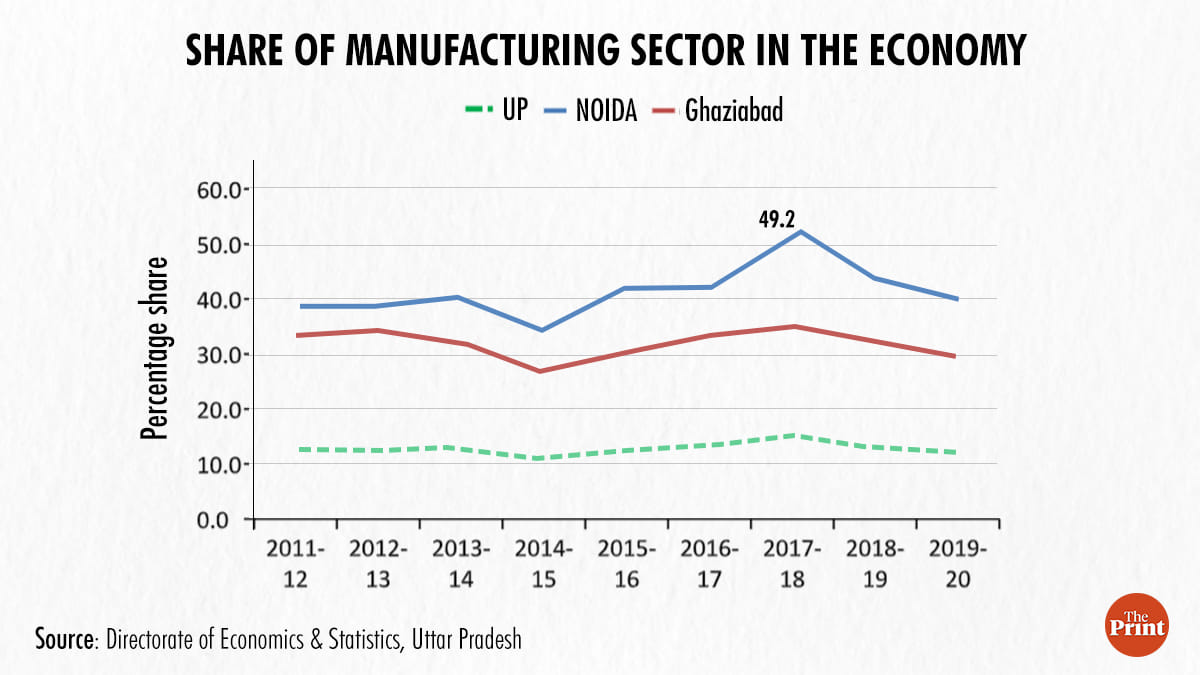
In addition to manufacturing, the construction sector has emerged as the fastest-growing sector in the two districts (Figure 4). The proximity to Delhi is generally seen as the biggest reason for the booming construction sector in the satellite districts (also for Faridabad and Gurgaon). Interestingly, construction was less than the state average (14.3 per cent) in both these districts in 2011-2012. But it has since risen steeply. There has been a rapid rise in the growth of the sector, which was much steeper in Noida during the 2012-17 period. The sector seems to have suffered during the 2017-18 period, which may have been on account of demonetisation, as suggested by a few experts at the time. It then seemed to have recovered since. In 2019-20, the construction sector contributed around 18 per cent towards these districts’ overall economy.
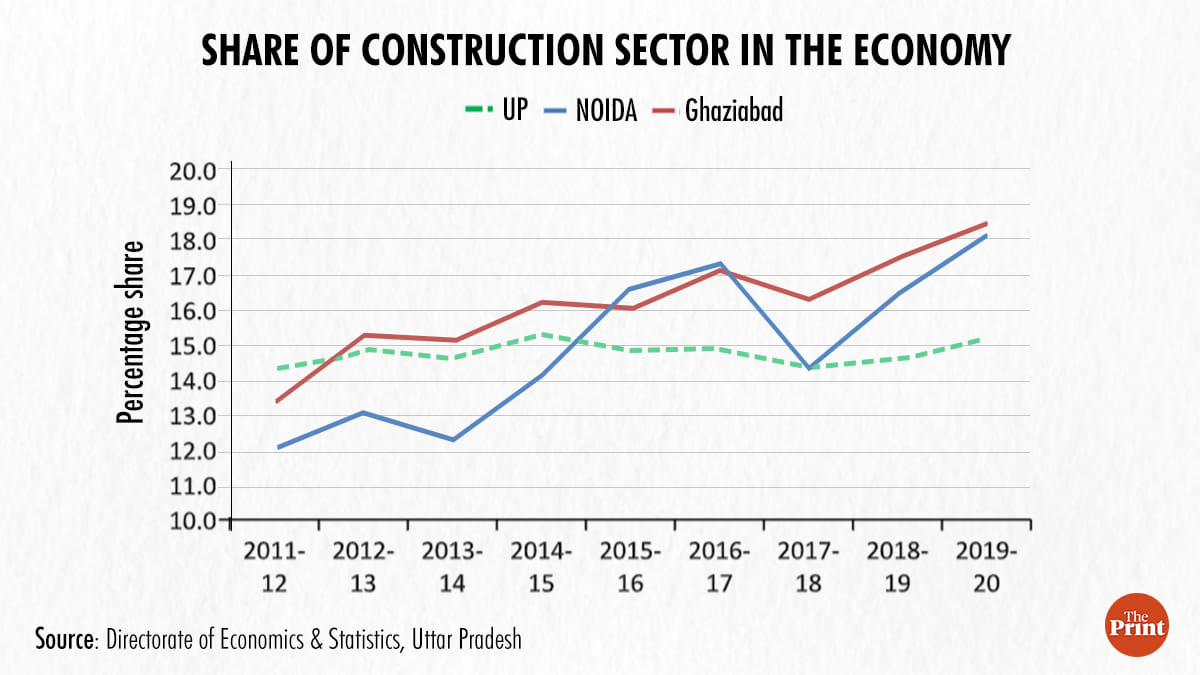
Even though the two districts (Noida and Ghaziabad) share their geographical boundaries with the NCR of Delhi, their growth path has evolved differently, especially in the last decade. Noida has emerged as the manufacturing hub and real estate magnate of the region. This may have been on account of multiple factors. The emergence of Noida as the growth centre, especially in the western region (also Agra), is certain to have deepened the already existing east-west regional divide in the state. With the proposed Jewar airport, the district is likely to benefit even more. On the other hand, Ghaziabad seems to be losing its golden opportunity. Is it too late for the district and the state administration to wake up and save it from becoming a ‘bedroom community’ for those working in Noida and Delhi? Only time will tell.
Vikash Vaibhav is Assistant Professor, Dr. B.R. Ambedkar School of Economics, Bangalore.
Varun Kumar Das is Assistant Professor, Delhi School of Economics. Views are personal.
(Edited by Srinjoy Dey)



